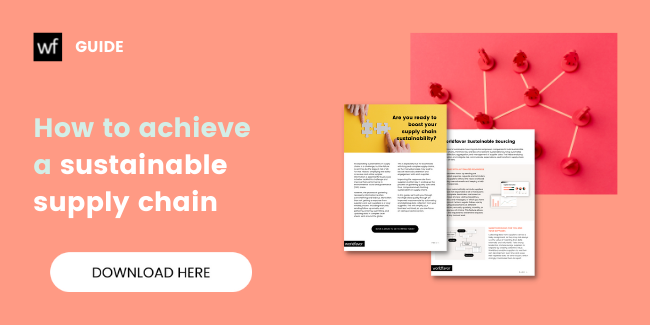
In a globalized world, any sustainable supply chain is going to rely on companies, organizations and retailers being able to build positive relationships with their respective suppliers. The social and environmental costs now have to be considered at every tier, with reputational damage and financial ruin potentially at stake. It’s often easier said than done, but legislation and changing public attitudes have gone some way in forcing sustainability issues to the forefront of international attention, and it’s likely to continue over the next decade.
Consider the Paris Agreement, which sets clear targets for achieving climate and energy sustainability by 2030. A detailed report which looked at global trends in renewable energy investment found that;
“Private sector companies that have joined the RE100 group, pledging to source 100% of their power from renewables... RE100 members also have supply chains, with other companies selling them components, materials and services. Members are increasingly looking at moves to encourage, or even oblige, suppliers to ‘go green’ with their own electricity consumption.”
They estimate that commitments could entail a global cost of $1 trillion over the next decade, highlighting the need to work with suppliers to streamline the process. Whether it be environmental sustainability or making sure human rights breaches are not occurring downstream, organizations’ relationships with suppliers are critical in order to make sure that suppliers honestly comply, actively track, and build a transparent relationship that will ultimately push the sustainable business forward.
Building mutual relationships with suppliers
Inadequate sustainability performance can have an impact on a company’s growth, especially if they land in hot water with consumers or regulators. It’s the reason why avoiding associated risks is one of the major driving forces behind sustainable supply chains for businesses around the globe.
Organizations also need critical information from suppliers in order to understand their supply chain impact and make informed, sustainable decisions in the long-term. Consider the example of sustainability and compliance information. The better the relationship you have with suppliers, the more likely you are to have a better understanding of your supply chain, and ways you can improve and mitigate risk.For example, using fewer materials and less energy is one method of improving sustainability, especially as a typical supply chain has more social and environmental costs than its operations account for.
You can gauge the relationship between your organization and any suppliers by looking at the response rate, while making an effort to improve the average. Supplier response rate is a critical measurement in understanding the health of your relationship with suppliers because it shows the rate at which suppliers are interacting with you and answering requests and keeping information up-to-date. The better your response rate, the more likely suppliers are working actively with sustainability questions.
To achieve the best results in terms of building relationships, it’s worth taking the time to find suppliers that are willing to comply with your specific standards, as well as those who will adapt to the ever-changing needs of your customers and shareholders. For example, consider whether your company and your suppliers share the same core values, as it’s often inefficient if you attempt to use leverage to change their practices unwillingly.
Authentic collaboration is highly effective, as you’ll have the ability to work towards a common cause with other tiers in your supply chain, rather than forcing them to do so begrudgingly. (There’s also less chance of them falsifying data in an attempt to appease higher tiers.)
Methods of collaborative sustainable efforts between companies and their suppliers have continued to be refined and improved over the years, aided in no small part by the rise of digital technology and updated procedures. These can take the form of asking a staff member to go over sustainable procedures with a new supplier or taking the time to go over their code of conduct to ensure that there won’t be any risks later down the line. Investing in sustainable supplier relationships will ultimately breed a trustworthy relationship between buyers and suppliers. This will increase value for suppliers and build a resilient supply chain for buyers.
Improving supplier relationships with technology
The rise of digital technology has also allowed for a range of online solutions when working with valued suppliers. It’s a world away from traditional methods, which entails manually requesting and following up on very specific information from many suppliers on several tiers to get and track compliance and sustainability data. This is especially true when you consider improvements in communication tech since the turn of the millennium. Think of the difference in speed when comparing email to snail-mail, or how fax machines are almost obsolete now that internet speeds are relatively fast and anyone can send a document with a couple of clicks.
Specialized platforms are often the best method for keeping up with supplier relationships. Sustainable sourcing solutions tend to offer better results faster, with features that automate the administrative load between suppliers and buyers and allow organizations to focus on making proactive sustainable change from automated analyses of the information instead. For example, automatic emails and follow-ups requesting information customized to that supplier will keep you one step ahead of any problems, while streamlined communication via one platform allows for synchronized teamwork, control and engagement – both internally and throughout your chain. It’s a pain to talk to different suppliers and clients through a range of manual emails, Excel spreadsheets, or a variety of different systems, so it’s worth consolidating everything onto a platform you can trust.
On the other side of the equation, suppliers are able to track their own sustainability when they report to you, although they may need to be encouraged to submit data and work on their own sustainability practices. A sourcing solution will help to improve your response rates, while it’s a simplified process to ensure ease of use for all parties. You’ll just have to convince them that it is in their best interests to be transparent and open with their data and compliance, especially as regulations and targets such as the Paris Agreement continue to ramp up in the coming decade. It’s worth taking the time to get to know your suppliers, to build trust, ensure that you’re on the same page, and have a solid relationship to lean back on in case crisis strikes.
In the past, sustainable supply chains weren’t necessarily considered a risk for businesses, which were often content to outsource to the cheapest, or the fastest suppliers depending on their budget and specifications. It’s just not viable anymore considering the risks, while sustainable sourcing tech is well placed to ensure that your company can build a trusting relationship with suppliers in order to grow sustainably, gain an insight into your supply chain, and mitigate risk. Above all, the better your relationship with a supplier, the more likely you’re on the path to improving business sustainability.
Related blog posts you might like:







%20as%20the%20deadline%20approaches.%20Learn%20about%20compliance%20requirements%2c%20potential%20delays%2c%20and%20key%20updates..png)

